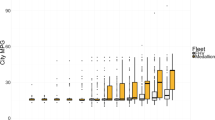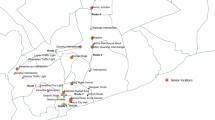Abstract
Exposure to fine particulate matter (PM2.5) and black carbon (BC) have been linked to negative health risks, but exposure among professional taxi drivers is understudied. This pilot study measured drivers’ knowledge, attitudes, and beliefs (KAB) about air pollution compared with direct measures of exposures. Roadside and in-vehicle levels of PM2.5 and BC were continuously measured over a single shift on each subject, and exposures compared with central site monitoring. One hundred drivers completed an air pollution KAB questionnaire, and seven taxicabs participated in preliminary in-cab air sampling. Taxicab PM2.5 and BC concentrations were elevated compared with nearby central monitoring. Average PM2.5 concentrations per 15-min interval were 4–49 μg/m3. BC levels were also elevated; reaching>10 μg/m3. Fifty-six of the 100 drivers surveyed believed they were more exposed than non-drivers; 81 believed air pollution causes health problems. Air pollution exposures recorded suggest that driver exposures would likely exceed EPA recommendations if experienced for 24 h. Surveys indicated that driver awareness of this was limited. Future studies should focus on reducing exposures and increasing awareness among taxi drivers.
This is a preview of subscription content, access via your institution
Access options
Subscribe to this journal
Receive 6 print issues and online access
$259.00 per year
only $43.17 per issue
Buy this article
- Purchase on Springer Link
- Instant access to full article PDF
Prices may be subject to local taxes which are calculated during checkout

Similar content being viewed by others
References
United States Environmental Protection Agency. Integrated Science Assessment for Particulate Matter (Final Report). Washington, DC, 2009.
United States Environmental Protection Agency. Particulate Matter. Available from http://www.epa.gov/pm/ (accessed November 2016).
Hudda N, Eckel SP, Knibbs LD, Sioutas C, Delfino RJ, Fruin SA . Linking in-vehicle ultrafine particle exposures to on-road concentrations. Atmos Environ 2012; 59: 578–586.
Pui DY, Qi C, Stanley N, Oberdörster G, Maynard A . Recirculating air filtration significantly reduces exposure to airborne nanoparticles. Environ Health Perspect 2008; 116: 863–866.
World Health Organization. World Health Organization Report: Health Effects of Black Carbon, 2012.
Dockery DW, Pope CA, Xu X, Spengler JD, Ware JH, Fay ME et al. An association between air pollution and mortality in six U.S. cities. N Engl J Med 1993; 329: 1753–1759.
Koton S, Molshatzki N, Yuval, Myers V, Broday DM, Drory Y et al. Cumulative exposure to particulate matter air pollution and long-term post-myocardial infarction outcomes. Prev Med 2013; 57: 339–344.
Fang SC, Cassidy A, Christiani DC . A systematic review of occupational exposure to particulate matter and cardiovascular disease. Int J Environ Res Public Health 2010; 7: 1773–1806.
Brook RD, Cakmak S, Turner MC, Brook JR, Crouse DL, Peters PA et al. Long-term fine particulate matter exposure and mortality from diabetes in Canada. Diabetes Care 2013; 36: 3313–3320.
Hansen J, Raaschou-Nielsen O, Olsen JH . Increased risk of lung cancer among different types of professional drivers in Denmark. Occup Environ Med 1998; 55: 115–118.
Jakobsson R, Gustavsson P, Lundberg I . Increased risk of lung cancer among male professional drivers in urban but not rural areas of Sweden. Occup Environ Med 1997; 54: 189–193.
Spira-Cohen A, Chen LC, Kendall M, Sheesley R, Thurston GD . Personal exposures to traffic-related particle pollution among children with asthma in the South Bronx, NY. J Expo Sci Environ Epidemiol 2010; 20: 446–456.
Spira-Cohen A, Chen LC, Kendall M, Lall R, Thurston GD . Personal exposures to traffic-related air pollution and acute respiratory health among Bronx school children with asthma. Environ Health Perspect 2011; 119: 559–565.
Delfino RJ, Sioutas C, Malik S . Potential role of ultrafine particles in associations between airborne particle mass and cardiovascular health. Environ Health Perspect 2005; 113: 934–946.
Li N, Wang M, Bramble LA, Schmitz DA, Schauer JJ, Sioutas C et al. The adjuvant effect of ambient particulate matter is closely reflected by the particulate oxidant potential. Environ Health Perspect 2009; 117: 1116–1123.
Weichenthal S, Kulka R, Dubeau A, Martin C, Wang D, Dales R . Traffic-related air pollution and acute changes in heart rate variability and respiratory function in urban cyclists. Environ Health Perspect 2011; 119: 1373–1378.
Berger A, Zareba W, Schneider A, Ruckerl R, Ibald-Mulli A, Cyrys J et al. Runs of ventricular and supraventricular tachycardia triggered by air pollution in patients with coronary heart disease. J Occup Environm Med 2006; 48: 1149–1158.
Chan CC, Chuang KJ, Shiao GM, Lin LY . Personal exposure to submicrometer particles and heart rate variability in human subjects. Environ Health Perspect 2004; 112: 1063–1067.
United States Environmental Protection Agency. National Ambient Air Quality Standards (NAAQS). Available from http://www.epa.gov/air/criteria.html (accessed November 2016).
Geiss O, Barrero-Moreno J, Tirendi S, Kotzias D . Exposure to particulate matter in vehicle cabins of private cars. Aerosol Air Qual Res 2010; 10: 581–588.
Praml G, Schierl R . Dust exposure in Munich public transportation: a comprehensive 4-year survey in buses and trams. Int Arch Occup Environ Health 2000; 73: 209–214.
Adams HS, Nieuwenhuijsen MJ, Colvile RN, McMullen MA, Khandelwal P . Fine particle (PM2.5) personal exposure levels in transport microenvironments, London, UK. Sci Total Environ 2001; 279: 29–44.
Riediker M, Cascio WE, Griggs TR, Herbst MC, Bromberg PA, Neas L et al. Particulate matter exposure in cars is associated with cardiovascular effects in healthy young men. Am J Respir Crit Care Med 2004; 169: 934–940.
Leung PL, Harrison RM . Evaluation of personal exposure to monoaromatic hydrocarbons. Occup Environ Med 1998; 55: 249–257.
Westerdahl D, Fruin S, Sax T, Fine PM, Sioutas C . Mobile platform measurements of ultrafine particles and associated pollutant concentrations on freeways and residential streets in Los Angeles. Atmospheric Environment 2005; 39: 3597–3610.
Fruin S, Westerdahl D, Sax T, Sioutas C, Fine PM . Measurements and predictors of on-road ultrafine particle concentrations and associated pollutants in Los Angeles. Atmospheric Environment 2008; 42: 207–219.
Klepeis NE, Nelson WC, Ott WR, Robinson JP, Tsang AM, Switzer P et al. The National Human Activity Pattern Survey (NHAPS): a resource for assessing exposure to environmental pollutants. J Expo Anal Environ Epidemiol 2001; 11: 231–252.
Fruin SA, Winer AM, Rodes CE . Black carbon concentrations in California vehicles and estimation of in-vehicle diesel exhaust particulate matter exposures. Atmospheric Environment 2004; 38: 4123–4133.
Schneider CG, Hill B . Clean Air Task Force. No Escape From Diesel Exhaust: How to Reduce Commuter Exposure. Boston, MA, 2007.
Torricelli AA, Matsuda M, Novaes P, Braga AL, Saldiva PH, Alves MR et al. Effects of ambient levels of traffic-derived air pollution on the ocular surface: analysis of symptoms, conjunctival goblet cell count and mucin 5AC gene expression. Environ Res 2014; 131: 59–63.
Yassky D, Chhabra A, Gallo E, Miller D, 2014 Taxicab FactBook: New York City Taxi & Limousine Commission, 2014. Available from http://www.nyc.gov/html/tlc/downloads/pdf/2014_taxicab_fact_book.pdf (accessed November 2016).
Bickerstaff K, Walker G . Public understandings of air pollution: the “localisation” of environmental risk. Global Environmental Change 2001; 11: 145.
NYS Department of Environmental Conservation. Air Monitoring Sites: All Parameters, NYC Area. NYSDEC Air Monitoring Sites in NYC 2013 2013. Available from http://www.dec.ny.gov/chemical/27442.html.
Schaller Consulting. The changing face of taxi and limousine drivers, U.S., large states and metro areas and New York City Brooklyn: Schaller Consult 2004. Available fromhttp://www.schallerconsult.com/taxi/taxidriver.pdf (accessed November 2016).
Waheed S, Romero-Alston L . UNFARE taxi drivers and the cost of moving the city. A report by the Community Development Project of the Urban Justice Center. Prepared for the New York Taxi Workers Alliance. 2003. Available from http://www.urbanjustice.org/pdf/publications/Unfare.pdf (accessed November 2016).
Gany F, Gill P, Ahmed A, Acharya S, Leng J . "Every disease… man can get can start in this cab": focus groups to identify south Asian taxi drivers’ knowledge, attitudes and beliefs about cardiovascular disease and its risks. J Immigr Minor Health 2013; 15: 986–992.
Apantaku-Onayemi F, Baldyga W, Amuwo S, Adefuye A, Mason T, Mitchell R et al. Driving to better health: cancer and cardiovascular risk assessment among taxi cab operators in Chicago. J Health Care Poor Underserved 2012; 23: 768–780.
Garshick E, Laden F, Hart JE, Rosner B, Davis ME, Eisen EA et al. Lung cancer and vehicle exhaust in trucking industry workers. Environ Health Perspect 2008; 116: 1327–1332.
Hart JE, Garshick E, Smith TJ, Davis ME, Laden F . Ischaemic heart disease mortality and years of work in trucking industry workers. Occup Environ Med 2013; 70: 523–528.
IARC Working Group on the Evaluation of Carcinogenic Risks to Humans. Carbon black, titanium dioxide, and talc IARC Monogr Eval Carcinog Risks Hum 2010; 93: 1–413.
Bräuner EV, Forchhammer L, Møller P, Barregard L, Gunnarsen L, Afshari A et al. Indoor particles affect vascular function in the aged: an air filtration-based intervention study. Am J Respir Crit Care Med 2008; 177: 419–425.
Glasgow RE . National Cancer Institute. Health Behavior Constructs: Theory, Measurement & Research. Perceived Barriers to Self-Management and Preventive Behaviors Colorado: Kaiser Permanente. Available from http://cancercontrol.cancer.gov/BRP/constructs/barriers/index.html (accessed November 2016).
Becker MH, Maiman LA, Kirscht JP, Haefner DP, Drachman RH, Taylor DW . Patient perceptions and compliance: recent studies of the Health Belief Model. In: RBHDL Sckett (ed). Compliance in Health Care. Johns Hopkins University Press: Baltimore. 1979.
Bandura A . Health promotion by social cognitive means. Health Educ Behav 2004; 31: 143.
Stokols D . Translating social ecological theory into guidelines for community health promotion. Am J Health Promot 1996; 10: 282–298.
Restrepo C, Zimmerman R, Thurston G, Clemente J, Gorczynski J, Zhong M et al. A comparison of ground-level air quality data with New York State Department of Environmental Conservation monitoring stations data in South Bronx, New York. Atmospheric Environment 2004; V38: 5283–5294.
Acknowledgements
Work was performed for this study at Memorial Sloan Kettering Cancer Center and New York University School of Medicine. Data analysis and survey development for this study were supported by the National Institute on Minority Health and Health Disparities under Award Number R24MD008058. Exposure assessment was supported by the National Institute of Environmental Health Sciences under Award Number ES000260. This study was also conducted with support from the U54 CCNY-MSKCC Partnership for Cancer Research, Training & Community Outreach - Partnership Community Outreach-Research-Education (PCORE) Core.
Author information
Authors and Affiliations
Corresponding author
Ethics declarations
Competing interests
The authors declare no conflict of interest.
Rights and permissions
About this article
Cite this article
Gany, F., Bari, S., Prasad, L. et al. Perception and reality of particulate matter exposure in New York City taxi drivers. J Expo Sci Environ Epidemiol 27, 221–226 (2017). https://doi.org/10.1038/jes.2016.23
Received:
Accepted:
Published:
Issue Date:
DOI: https://doi.org/10.1038/jes.2016.23
Keywords
This article is cited by
-
How do taxi drivers expose to fine particulate matter (PM2.5) in a Chinese megacity: a rapid assessment incorporating with satellite-derived information and urban mobility data
International Journal of Health Geographics (2024)
-
The Association of Untreated Mental Health Problems with Alcohol and Tobacco use Among New York City Taxi Drivers
Journal of Community Health (2023)
-
Informing about the invisible: communicating en route air pollution and noise exposure to cyclists and pedestrians using focus groups
European Transport Research Review (2022)
-
Health risk assessment of inhalational exposure to heavy metals in drivers working in an urban desert city in the Middle East
Environmental Monitoring and Assessment (2022)
-
Impacts of Personalized Sensor Feedback Regarding Exposure to Environmental Stressors
Current Pollution Reports (2021)



